|
|
|
Sort Order |
|
|
|
Items / Page
|
|
|
|
|
|
|
| Srl | Item |
| 1 |
ID:
165453
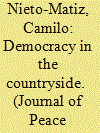

|
|
|
|
|
| Summary/Abstract |
What are the subnational variations of violence against voters? This article studies the effect of land concentration on electoral violence in the context of armed conflict in Colombia. My central argument is that electoral violence tends to be higher in municipalities where landowners are a relevant social actor. More concretely, in areas where violent groups dispute territorial control, higher levels of land inequality – a proxy for landowner prominence – have a positive effect on electoral violence. However, actors do not make the simple choice between violence or no violence but may also resort to fraudulent tactics. Because electoral fraud requires greater cooperation and coordination with the state, I argue that violent groups with stronger links to state officials and political elites are more likely to engage in fraudulent tactics compared to anti-government actors. To estimate the effect of land inequality on electoral coercion and fraud, I exploit the levels of soil quality as an instrumental variable for land concentration in Colombia between 2002 and 2011. This article contributes to the literature on the politics of land inequality; elections and electoral manipulation; and the use of violence in democratic settings.
|
|
|
|
|
|
|
|
|
|
|
|
|
|
|
|
| 2 |
ID:
165448
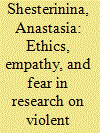

|
|
|
|
|
| Summary/Abstract |
The discussion of ethics in the social sciences focuses on ‘doing no harm’ and ‘giving back’ to research participants, but does not explore the challenges of empathy and fear in research with participants in political violence and war. Drawing on 180 in-depth interviews on the Georgian–Abkhaz war of 1992–93 collected over eight months between 2010 and 2013 primarily in Abkhazia, but also Georgia and Russia, I argue that researchers can come to empathize with some but fear other participants in past and present violence. These emotional responses can influence researchers’ ability to probe and interpret interviews and respondents’ ability to surpass strong positions to explore dilemmas of participation in violence. By empathizing with not only ‘victims’ and ‘non-fighters’ as I had expected based on my pre-existing moral-conceptual categories, but also participants in the war, I found that individuals adopted multiple overlapping roles and shifted between these roles in the changing conditions of violence. In contrast, failing to empathize with and fearing those who continued to participate in violence after the war of 1992–93 limited my ability to fully appreciate the complexity of their participation, but shed light on the context of violence in contemporary Abkhazia. This analysis shows that reflection on the role of empathy and fear in shaping our interactions with research participants can help advance our understanding of participation in violence and this difficult research context.
|
|
|
|
|
|
|
|
|
|
|
|
|
|
|
|
| 3 |
ID:
165447
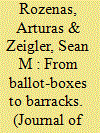

|
|
|
|
|
| Summary/Abstract |
The military often intervenes in politics shortly after elections. This might be because election results reveal information about the ease with which a coup can succeed. Would-be coup perpetrators use this information to infer whether the incumbent can be removed from office without provoking popular unrest. We argue that the informational content of elections depends on the electoral rules that translate votes into outcomes. In electoral systems that incentivize strategic voting, election returns are less informative about the distribution of political support than in electoral systems that incentivize sincere voting. An extensive battery of statistical tests shows that vote-shares of election winners do not predict coup attempts in plurality systems, which encourage strategic voting, but they do predict coup attempts in non-plurality electoral systems, which do not encourage strategic voting. Thus, incumbents who have performed well in elections face a lower risk of coup attempts, but only in institutional environments where voting results are highly informative about the distribution of political support. We apply this logic to illuminate the decisions of the military to intervene into politics during the famous failed 1936 coup in Spain and the successful 1973 coup in Chile.
|
|
|
|
|
|
|
|
|
|
|
|
|
|
|
|
| 4 |
ID:
165449
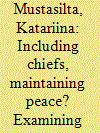

|
|
|
|
|
| Summary/Abstract |
The continued influence of traditional governance in sub-Saharan Africa has sparked increasing attention among scholars exploring the role of non-state and quasi-state forms of governance in the modern state. However, little attention has been given to cross-country and over-time variation in the interaction between state and traditional governance structures, particularly in regard to its implications for intrastate peace. This study examines the conditions under which traditional governance contributes to state capacity to maintain peace. The article argues that the type of institutional interaction between the state and traditional authority structures influences a country’s overall governance dynamics and its capacity to maintain peace. By combining new data on state–traditional authorities’ interaction in sub-Saharan Africa from 1989 to 2012 with intrastate armed conflict data, I conduct a systematic comparative analysis of whether concordant state–traditional authorities’ interaction strengthens peace. The empirical results support the argument that integrating traditional authorities into the public administration lowers the risk of armed conflict in comparison to when they remain unrecognized by the state. Moreover, the analysis suggests that the added value of this type of interaction is conditional on the colonial history of a country.
|
|
|
|
|
|
|
|
|
|
|
|
|
|
|
|
| 5 |
ID:
165456
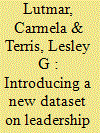

|
|
|
|
|
| Summary/Abstract |
Leaders and leadership changes are found to influence states’ foreign policy decisions, in particular with respect to war and peace between states. Although this issue is also addressed in the qualitative literature on intrastate wars, the influence of leadership turnovers in civil war has received limited systematic attention. One reason for this is the scarcity of quantitative data on rebel group leaderships. To fill this gap, we present a comprehensive dataset on leadership changes in rebel groups, 1946–2010, organized by rebel-month. The effects of leadership changes among parties engaged in civil war are argued to be more complex than those found in interstate disputes. In this article we present our theoretical argument followed by presentation of the variables in the dataset and descriptive statistics. To demonstrate the potential research value of the dataset we examine the impact of leader shifts on civil war settlement in Africa. We conclude with avenues for future research which might benefit from this dataset.
|
|
|
|
|
|
|
|
|
|
|
|
|
|
|
|
| 6 |
ID:
165455
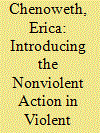

|
|
|
|
|
| Summary/Abstract |
Scholarship on civil war is overwhelmingly preoccupied with armed activity. Data collection efforts on actors in civil wars tend to reflect this emphasis, with most studies focusing on the identities, attributes, and violent behavior of armed actors. Yet various actors also use nonviolent methods to shape the intensity and variation of violence as well as the duration of peace in the aftermath. Existing datasets on mobilization by non-state actors – such as the Armed Conflict Events and Location (ACLED), Integrated Conflict Early Warning System (ICEWS), and Social Conflict Analysis Database (SCAD) – tend to include data on manifest contentious acts, such as protests, strikes, and demonstrations, and exclude activities like organizing, planning, training, negotiations, communications, and capacity-building that may be critical to the actors’ ultimate success. To provide a more comprehensive and reliable view of the landscape of possible nonviolent behaviors involved in civil wars, we present the Nonviolent Action in Violent Contexts (NVAVC) dataset, which identifies 3,662 nonviolent actions during civil wars in Africa between 1990 and 2012, across 124 conflict-years in 17 countries. In this article, we describe the data collection process, discuss the information contained therein, and offer descriptive statistics and discuss spatial patterns. The framework we develop provides a powerful tool for future researchers to use to categorize various types of nonviolent action, and the data we collect provide important evidence that such efforts are worthwhile.
|
|
|
|
|
|
|
|
|
|
|
|
|
|
|
|
| 7 |
ID:
165451
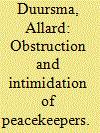

|
|
|
|
|
| Summary/Abstract |
While recent research focuses on why conflict parties attack peacekeepers, little attention has been given to other types of resistance against peacekeeping missions, such as intimidation and obstruction. It is argued in this article that one reason why peacekeepers are obstructed and intimidated is that armed actors that target civilians want to maintain the operational space to carry out attacks against civilians and want to prevent peacekeepers from monitoring human rights violations. A spatially and temporally disaggregated analysis on resistance against peacekeepers in Darfur between January 2008 and April 2009 indeed suggests that the intimidation and obstruction of peacekeepers is more likely to take place in areas with higher levels of violence against civilians. The findings hold when taking into account the non-random occurrence of violence against civilians through matching the data. Finally, anecdotal evidence from other sites of armed conflict than Darfur suggests that resistance against peacekeepers in these cases is also likely to be related to the targeting of civilians. This suggest that in order to be effective in protecting civilians, peace missions should not only be robust as highlighted in previous research, but peace missions should also develop an effective strategy to deal with armed groups that try to prevent peacekeepers from fulfilling their mandate.
|
|
|
|
|
|
|
|
|
|
|
|
|
|
|
|
| 8 |
ID:
165450
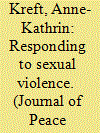

|
|
|
|
|
| Summary/Abstract |
Gender scholars show that women in situations of civil war have an impressive record of agency in the social and political spheres. Civilian women’s political mobilization during conflict includes active involvement in civil society organizations, such as nongovernmental organizations or social movements, and public articulation of grievances – in political protest, for example. Existing explanations of women’s political mobilization during conflict emphasize the role of demographic imbalances opening up spaces for women. This article proposes a complementary driving factor: women mobilize politically in response to the collective threat that conflict-related sexual violence constitutes to women as a group. Coming to understand sexual violence as a violent manifestation of a patriarchal culture and gender inequalities, women mobilize in response to this violence and around a broader range of women’s issues with the goal of transforming sociopolitical conditions. A case study of Colombia drawing on qualitative interviews illustrates the causal mechanism of collective threat framing in women’s collective mobilization around conflict-related sexual violence. Cross-national statistical analyses lend support to the macro-level implications of the theoretical framework and reveal a positive association between high prevalence of conflict-related rape on the one hand and women’s protest activity and linkages to international women’s nongovernmental organizations on the other.
|
|
|
|
|
|
|
|
|
|
|
|
|
|
|
|
| 9 |
ID:
165452
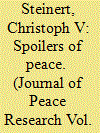

|
|
|
|
|
| Summary/Abstract |
This study investigates how deployment of pro-government militias (PGMs) as counterinsurgents affects the risk of conflict recurrence. Militiamen derive material and non-material benefits from fighting in armed conflicts. Since these will likely have diminished after the conflict’s termination, militiamen develop a strong incentive to spoil post-conflict peace. Members of pro-government militias are particularly disadvantaged in post-conflict contexts compared to their role in the government’s counterinsurgency campaign. First, PGMs are usually not present in peace negotiations between rebels and governments. This reduces their commitment to peace agreements. Second, disarmament and reintegration programs tend to exclude PGMs, which lowers their expected and real benefits from peace. Third, PGMs might lose their advantage of pursuing personal interests while being protected by the government, as they become less essential during peacetimes. To empirically test whether conflicts with PGMs as counterinsurgents are more likely to break out again, we identify PGM counterinsurgent activities in conflict episodes between 1981 and 2007. We code whether the same PGM was active in a subsequent conflict between the same actors. Controlling for conflict types, which is associated with both the likelihood of deploying PGMs and the risk of conflict recurrence, we investigate our claims with propensity score matching, statistical simulation, and logistic regression models. The results support our expectation that conflicts in which pro-government militias were used as counterinsurgents are more likely to recur. Our study contributes to an improved understanding of the long-term consequences of employing PGMs as counterinsurgents and highlights the importance of considering non-state actors when crafting peace and evaluating the risk of renewed violence.
|
|
|
|
|
|
|
|
|
|
|
|
|
|
|
|
| 10 |
ID:
165446


|
|
|
|
|
| Summary/Abstract |
This article presents ViEWS – a political violence early-warning system that seeks to be maximally transparent, publicly available, and have uniform coverage, and sketches the methodological innovations required to achieve these objectives. ViEWS produces monthly forecasts at the country and subnational level for 36 months into the future and all three UCDP types of organized violence: state-based conflict, non-state conflict, and one-sided violence in Africa. The article presents the methodology and data behind these forecasts, evaluates their predictive performance, provides selected forecasts for October 2018 through October 2021, and indicates future extensions. ViEWS is built as an ensemble of constituent models designed to optimize its predictions. Each of these represents a theme that the conflict research literature suggests is relevant, or implements a specific statistical/machine-learning approach. Current forecasts indicate a persistence of conflict in regions in Africa with a recent history of political violence but also alert to new conflicts such as in Southern Cameroon and Northern Mozambique. The subsequent evaluation additionally shows that ViEWS is able to accurately capture the long-term behavior of established political violence, as well as diffusion processes such as the spread of violence in Cameroon. The performance demonstrated here indicates that ViEWS can be a useful complement to non-public conflict-warning systems, and also serves as a reference against which future improvements can be evaluated.
|
|
|
|
|
|
|
|
|
|
|
|
|
|
|
|
| 11 |
ID:
165454
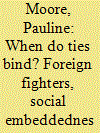

|
|
|
|
|
| Summary/Abstract |
How do foreign fighters affect civilian victimization in the civil wars they join? Scholars of civil war have gone to great lengths to explain why states and insurgent groups victimize civilians, but they have not explicitly examined the impact of foreign combatants. Furthermore, while contemporary conventional wisdom attaches an overwhelmingly negative connotation to foreign fighters, history shows that the behavior of those who travel to fight in wars far from home varies significantly, especially when it comes to interacting with local populations. To address this variation, I demonstrate how differences in the embeddedness of foreign fighter populations combine with incentives that foreign fighters face to remain in the conflict zone over the long term to shape tendencies towards civilian victimization. My findings from an analysis of insurgent groups from 1990 to 2011 suggest that, overall, foreign fighters lead to escalations in violence against civilians. When comparing across groups that recruit foreign fighters, however, levels of violence differ depending on foreign fighter populations’ coethnicity to the rebel groups they join, and the distances they travel to reach a conflict zone. Specifically, the presence of coethnic foreign fighters leads to fewer escalations in violence, relative to the recruitment of non-coethnic individuals from non-neighboring states. The study provides empirical support to the claim that degrees of embeddedness across foreign fighter populations are important indicators of when and where their presence is likely to pose significant dangers to local populations.
|
|
|
|
|
|
|
|
|
|
|
|
|
|
|
|
|
|
|
|
|